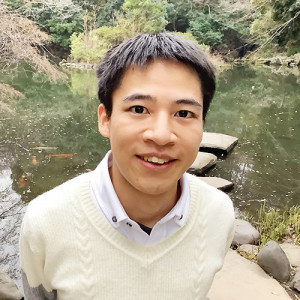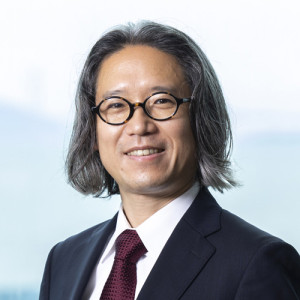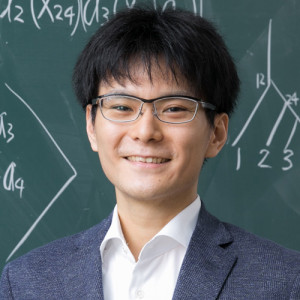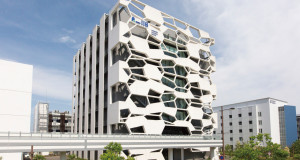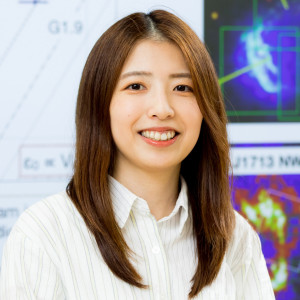Volume 198
Back to Newsletter List
Press Release
Discovering Speed Limits for Macroscopic Transitions - A Unified Approach Based on the Equation of Continuity
2022-05-09
Ryusuke Hamazaki (RIKEN Hakubi Team Leader, Nonequilibrium Quantum Statistical Mechanics RIKEN Hakubi Research Team / Senior Research Scientist, iTHEMS) has discovered a new inequality for the “speed limit," or transition rate, which is useful for physical processes that involve "macroscopic transitions". The research results are expected to have implications for nonequilibrium statistical mechanics, including the time scale of thermalization of quantum many-body systems. They are also expected to contribute to the fundamental understanding of quantum technology, e.g., the control of macroscopic quantum systems, which has become important in recent years.
Please see related link for more details.
Reference
- Ryusuke Hamazaki, Speed Limits for Macroscopic Transitions, PRX Quantum 3, 020319 (2022), doi: 10.1103/PRXQuantum.3.020319
Press Release
Clear Visualization of Lamb Waves from Tonga's Undersea Volcano Eruption -The Full Picture of the Waves Captured by the Himawari-8
2022-05-09
Takemasa Miyoshi (Deputy Program Director, iTHEMS / Team Leader, Data Assimilation Research Team, RIKEN Center for Computational Science (R-CCS)) and Shigenori Otsuka (Research Scientist, iTHEMS / Research Scientist, Data Assimilation Research Team, RIKEN Center for Computational Science (R-CCS)) have developed an original method to clearly visualize "Lamb waves," a type of sound wave associated with Tonga's undersea volcanic eruption in January 2022, using images from the Himawari 8 meteorological satellite. Furthermore, we developed a method to automatically extract the Lamb waves from this image and clarified the relationship between the distribution of arrival times and ground pressure observations.
The results of this research are expected to contribute to the scientific understanding and monitoring of atmospheric waves and associated tidal fluctuations caused by volcanic eruptions, and to the development of advanced simulations and future forecasting methods by integrating observation data with large-scale atmospheric and oceanographic calculations.
Please see related links for more details.
Reference
- Shigenori Otsuka, Visualizing Lamb Waves From a Volcanic Eruption Using Meteorological Satellite Himawari-8, Geophysical Research Letters, Volume 49, Issue 8 (2022), doi: 10.1029/2022GL098324
Upcoming Events
Seminar
Math-Phys Seminar
Recent Progress in the Swampland Program
May 19 (Thu) 14:00 - 15:30, 2022
Toshifumi Noumi (Associate Professor, Institute of Cosmophysics, Department of Physics, Graduate School of Science, Kobe University)
In the past years, it has become increasingly clear that there exist nontrivial consistency conditions on symmetries in quantum gravity, that are invisible in classical gravity. The Swampland program aims at identifying such quantum gravity constraints and their implications for particle physics and cosmology, toward quantum gravity phenomenology. In this talk, I will review recent progress in this program, including my own works.
Venue: Hybrid Format (Common Room 246-248 and Zoom)
Event Official Language: English
Seminar
Deviations from the Standard Model Predictions and New Physics Interpretations
May 20 (Fri) 13:30 - 15:00, 2022
Teppei Kitahara (Assistant Professor, Kobayashi-Maskawa Institute for the Origin of Particles and the Universe (KMI), Nagoya University)
Continuous development of experiments in recent years has revealed a large number of experimental anomalies which the Standard Model cannot explain. It is statistically obvious that as the number of experiments increases, one encounters a new anomaly due to the statistical fluctuation. But interestingly, some of the anomalies have been cross-checked by different experiments. These would be hints for physics beyond the Standard model. In this talk, I will review the flavor anomalies (also known as lepton flavor universality violation), the muon g-2 anomaly, and recently measured the W boson mass anomaly. I will also discuss these implications for the new physics, and introduce several of our works.
Venue: Hybrid Format (Common Room 246-248 and Zoom)
Event Official Language: English
Seminar
iTHEMS Math Seminar
A mathematical formulation of two-dimensional conformal field theory
May 23 (Mon) 14:00 - 16:30, 2022
Yuto Moriwaki (Special Postdoctoral Researcher, RIKEN Interdisciplinary Theoretical and Mathematical Sciences Program (iTHEMS))
The mathematical construction of non-trivial quantum field theory in four dimensions, known as the "Yang-Mills existence and mass gap problem", is a very important issue in mathematical sciences. There are many examples of rigorous quantum field theories in two dimensions, although the four dimensions have not yet been solved. In particular, two-dimensional conformal field theory, which is a quantum field theory with conformal symmetry, has good properties and can be formulated mathematically using algebraic structures formed by "products of a field and a field" (operator product expansion).
In this talk, this algebraic formulation (full vertex algebra) will be explained. Various construction methods and concrete examples (construction using codes, construction from quantum groups, and construction by deformation) will then be discussed.
All the talk here is mathematical, but I will try to speak in a way that is motivated by physics as much as possible throughout the talk. I hope to receive various comments from the viewpoints of other fields.
Venue: Hybrid Format (Common Room 246-248 and Zoom)
Event Official Language: English
Seminar
Quantum Matter Seminar
Introduction to Topological Insulators: The Ten-fold Classification of Topological Insulators and Superconductors Part.1
May 24 (Tue) 14:00 - 15:30, 2022
Ching-Kai Chiu (Senior Research Scientist, RIKEN Interdisciplinary Theoretical and Mathematical Sciences Program (iTHEMS))
References
- Andreas P. Schnyder, Shinsei Ryu, Akira Furusaki, and Andreas W. W. Ludwig, Classification of topological insulators and superconductors in three spatial dimensions, Phys. Rev. B 78, 195125 (2008), doi: 10.1103/PhysRevB.78.195125
- Alexei Kitaev, Periodic table for topological insulators and superconductors, AIP Conference Proceedings 1134, 22 (2009), doi: 10.1063/1.3149495
Venue: via Zoom
Event Official Language: English
Seminar
NEW WG Seminar
Equilibrium or not? Mathematical differences between acute & chronic virus infections
May 25 (Wed) 13:30 - 15:00, 2022
Catherine Beauchemin (Deputy Program Director, RIKEN Interdisciplinary Theoretical and Mathematical Sciences Program (iTHEMS))
The widely acclaimed 1995/1996 papers by Ho, Perelson and others [1,2] demonstrated the important insights that come from mathematical modelling of virus infection kinetics within a person. But there are key dynamical differences between chronic and acute infections, namely whether the infection reaches or maintains some equilibrium or not. In this talk, I will introduce the equations used to describe a virus infection within a person. I will show some of the tricks used by mathematical modellers to extract important rate estimates from measurements in patients infected with chronic diseases, like HIV or Hepatitis C virus. I will explain why it is difficult to extract meaningful information from measurements in patients with an acute infection, like influenza or possibly COVID-19 [3]. I hope to hear from the audience if they have any thoughts about overcoming the issue to extract better rate information from limited data in patients with acute infections.
(This seminar is a joint seminar between Nonequilibrium working group and Biology study group)
References
- Ho DD, Neumann AU, Perelson AS, Chen W, Leonard JM, Markowitz M., Rapid turnover of plasma virions and CD4 lymphocytes in HIV-1 infection, Nature 373 (6510) 123-6 (1995), doi: 10.1038/373123a0
- Perelson AS, Neumann AU, Markowitz M, Leonard JM, Ho DD, HIV-1 dynamics in vivo: virion clearance rate, infected cell life-span, and viral generation time, Science (1996), doi: 10.1126/science.271.5255.1582
- Palmer J, Dobrovolny HM, and Beauchemin CAA, The in vivo efficacy of neuraminidase inhibitors cannot be determined from the decay rates of influenza viral titers observed in treated patients, Sci. Rep., 7:40210 (2017), doi: doi:10.1038/srep40210
Venue: via Zoom
Event Official Language: English
Seminar
NEW WG Seminar
Superconducting-like heat current: Effective cancellation of current-dissipation trade-off by quantum coherence
July 25 (Mon) 13:30 - 15:00, 2022
Tajima Hiroyasu (Assistant Professor, Graduate School of Informatics and Engineering, The University of Electro-Communications)
Recent developments in statistical mechanics have revealed a tradeoff between heat current and dissipation [1,2]. In various situations, this current-dissipation tradeoff represents a relationship between thermal energy flow and entropy increase, similar to Joule’s law W=RI^2.
On the other hand, the coherence effect on the current-dissipation tradeoff has not been thoroughly analyzed. Here, we systematically analyze how coherence affects the current-dissipation tradeoff [3]. The results can be summarized in the following three rules:
- Quantum coherence between different energy levels strengthens the trade-off. In other words, the ratio between the square of the heat current and the entropy production ratio corresponding to electrical resistance R (hereafter referred to as "thermal resistance") is increased by the superposition of different energy levels.
- Coherence between degeneracies weakens the trade-off. That is, thermal resistance is weakened by coherence between degeneracies.
- With enough coherence between degeneracies, we can cancel the trade-off effectively and make the thermal resistance approximately zero. Then, macroscopic heat flow without entropy increase is realized.
These three results directly reveal the coherence effects on heat engine performance. That is, coherence between different energy levels reduces the performance, while coherence between degeneracies increases it. And when there is a sufficient amount of coherence between degeneracies, the efficiency can asymptotically reach the Carnot efficiency (η=η_{Car}-O(1/N)) while the power is O(N).
References
- N. Shiraishi, K. Saito, H. Tasaki, Universal Trade-Off Relation between Power and Efficiency for Heat Engines, Phys. Rev. Lett. 117, 190601 (2016), doi: 10.1103/PhysRevLett.117.190601
- A. C. Barato, U. Seifert, Thermodynamic Uncertainty Relation for Biomolecular Processes, Phys. Rev. Lett. 114, 158101 (2015), doi: 10.1103/PhysRevLett.114.158101
- H. Tajima, K. Funo, Superconducting-like Heat Current: Effective Cancellation of Current-Dissipation Trade-Off by Quantum Coherence, Phys. Rev. Lett. 127, 190604 (2021), doi: 10.1103/PhysRevLett.127.190604
Venue: via Zoom
Event Official Language: English
Workshop
DM3 - Deep insights and Multiple strategies for Deciphering the Mystery of Dark Matter
September 15 (Thu) - 17 (Sat) 2022
Venue: SUURI-COOL (Kobe), Room S704-S705, Integrated Innovation Building (IIB), Kobe Campus, RIKEN / via Zoom
Event Official Language: English
Upcoming Visitors
May 17 (Tue) - 20 (Fri) 2022 Toshifumi NoumiAssociate Professor, Institute of Cosmophysics, Department of Physics, Graduate School of Science, Kobe University Visiting Place: RIKEN Wako Campus |
May 18 (Wed) 2022 Naomi TsujiVisiting Scientist, RIKEN Interdisciplinary Theoretical and Mathematical Sciences Program (iTHEMS) / Assistant Professor, Faculty of Science, Kanagawa University Research fields: Astrophysics Visiting Place: RIKEN Wako Campus |
If you would like to cancel your subscription or change your email address,
please let us know via our contact form.
Copyright © iTHEMS, RIKEN. All rights reserved.


